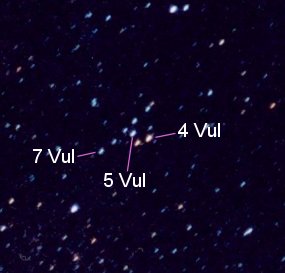THE COATHANGER
A Non-Cluster
 The "Coathanger Cluster" (also known as Brocchi's Cluster and more
formally as Collinder 399) is an almost startling sight when
encountered in the view of a small telescope. Visible to the naked
eye in the constellation Vulpecula, three
of the stars even have Flamsteed
numbers. Commonly taken as a real cluster, it isn't,
and thereby provides a strong lesson about statistics and about the
difficulties inherent in cluster research. The grouping, in the
heart of the Milky Way, is entirely a coincidence. Its stars range
from 200 to 1100 light years away. Moreover, the stars are not
moving together, but are going off in all sorts of different
directions. One of the most difficult tasks in dealing with real
clusters is "membership." What stars really belong, and what stars
are just in the way? The only way to tell is through
time-consuming measures of distance and motion. Nevertheless, the
"group," with its strong color contrasts (caused by differing
temperatures, cooler stars more red), is quite lovely to look at.
For more information, see Brian Skiff's article in the January
1998 edition of Sky and Telescope, where the non-cluster status
of the Coathanger was first brought to light.
The "Coathanger Cluster" (also known as Brocchi's Cluster and more
formally as Collinder 399) is an almost startling sight when
encountered in the view of a small telescope. Visible to the naked
eye in the constellation Vulpecula, three
of the stars even have Flamsteed
numbers. Commonly taken as a real cluster, it isn't,
and thereby provides a strong lesson about statistics and about the
difficulties inherent in cluster research. The grouping, in the
heart of the Milky Way, is entirely a coincidence. Its stars range
from 200 to 1100 light years away. Moreover, the stars are not
moving together, but are going off in all sorts of different
directions. One of the most difficult tasks in dealing with real
clusters is "membership." What stars really belong, and what stars
are just in the way? The only way to tell is through
time-consuming measures of distance and motion. Nevertheless, the
"group," with its strong color contrasts (caused by differing
temperatures, cooler stars more red), is quite lovely to look at.
For more information, see Brian Skiff's article in the January
1998 edition of Sky and Telescope, where the non-cluster status
of the Coathanger was first brought to light.
 The "Coathanger Cluster" (also known as Brocchi's Cluster and more
formally as Collinder 399) is an almost startling sight when
encountered in the view of a small telescope. Visible to the naked
eye in the constellation Vulpecula, three
of the stars even have Flamsteed
numbers. Commonly taken as a real cluster, it isn't,
and thereby provides a strong lesson about statistics and about the
difficulties inherent in cluster research. The grouping, in the
heart of the Milky Way, is entirely a coincidence. Its stars range
from 200 to 1100 light years away. Moreover, the stars are not
moving together, but are going off in all sorts of different
directions. One of the most difficult tasks in dealing with real
clusters is "membership." What stars really belong, and what stars
are just in the way? The only way to tell is through
time-consuming measures of distance and motion. Nevertheless, the
"group," with its strong color contrasts (caused by differing
temperatures, cooler stars more red), is quite lovely to look at.
For more information, see Brian Skiff's article in the January
1998 edition of Sky and Telescope, where the non-cluster status
of the Coathanger was first brought to light.
The "Coathanger Cluster" (also known as Brocchi's Cluster and more
formally as Collinder 399) is an almost startling sight when
encountered in the view of a small telescope. Visible to the naked
eye in the constellation Vulpecula, three
of the stars even have Flamsteed
numbers. Commonly taken as a real cluster, it isn't,
and thereby provides a strong lesson about statistics and about the
difficulties inherent in cluster research. The grouping, in the
heart of the Milky Way, is entirely a coincidence. Its stars range
from 200 to 1100 light years away. Moreover, the stars are not
moving together, but are going off in all sorts of different
directions. One of the most difficult tasks in dealing with real
clusters is "membership." What stars really belong, and what stars
are just in the way? The only way to tell is through
time-consuming measures of distance and motion. Nevertheless, the
"group," with its strong color contrasts (caused by differing
temperatures, cooler stars more red), is quite lovely to look at.
For more information, see Brian Skiff's article in the January
1998 edition of Sky and Telescope, where the non-cluster status
of the Coathanger was first brought to light.